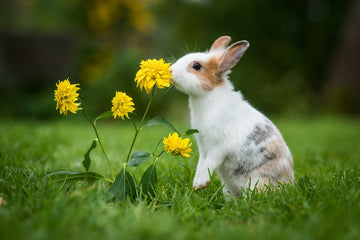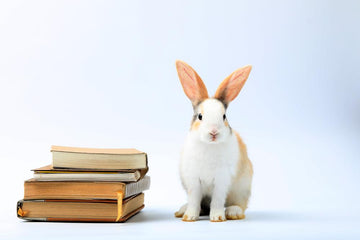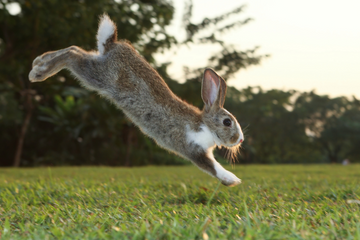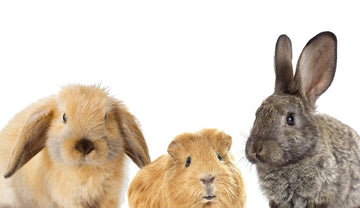What Type of Food to Feed Your Guinea Pig
As a new guinea pig owner, you want to provide the best guinea pig care possible. Yet, just like with any new piggie parent, you might not be too sure what type of hay you should be feeding them, what types of treats they can have, and if there is anything special you have to give them throughout the day.
Click Here to Shop Rabbit Products.

The largest part of your guinea pig’s diet should be hay – not pellets or veggies. To help make your transition into new parenthood easier, we’ve compiled a list of all the necessary guinea pig feeding tips that will help you start this new adventure off right!
Most Important Facts about Guinea Pigs
When it comes to being a guinea pig parent, there are two facts that are crucial to know in order to keep them happy and healthy.
Vitamin-C
Just like humans, guinea pigs don’t produce their own Vitamin-C and need it added to their daily diet. If they don’t receive the proper amount (talk to your vet to see how much your furry friend needs), they become vulnerable to developing scurvy which is sadly a common and painful cause of death among guinea pigs.
While you can purchase pellets, veggies, and fruits that contain Vitamin-C, many owners give Vitamin-C supplements to their guinea pigs to ensure they are getting the correct amount.
Teeth Growth
Your guinea pig’s teeth are constantly growing, just like rabbits and chinchillas. That means they require coarse hay or chew sticks to help them wear down their teeth naturally. If their teeth are left unkept they can become sharp and cause pain when your guinea pig eats, which decreases their appetite and risks creating problems within their digestive system.
Guinea Pig’s Diet
Your guinea pig’s diet should be made up of at least 80% grass hay, with the other 20% being pellets, veggies, and some fruits.
Hay
Grass hay, such as Timothy Hay, Orchard Grass, or Mountain Grass is an important staple in a guinea pig’s diet. For piggies who are 6 months and older, grass hay should make up 80% of their diet. The constant foraging and grazing encouraged by hay helps keep them physically active and mentally stimulated. It also helps wear down their teeth while the long strand fiber helps keep their digestion regular and functioning properly.
When your guinea pig doesn’t have the proper amount of coarse roughage and fiber, it can cause GI (gastrointestinal) stasis.
Water
Water is an extremely important part of your guinea pig’s diet. Fresh and clean water should be provided to your guinea pig at all times. You can give them easy access to water whenever they are thirsty by using a shallow bowl or water bottle next to their constant supply of hay. Many owners prefer to give them access to a water bottle instead of a bowl because guinea pigs don’t have any regard for keeping things clean. But you can test for yourself to see which one your guinea pig responds to better!
Pellets
When purchasing pellets for your guinea pig, make sure you look for ones that say they are fortified with Vitamin-C. Avoid pellets that have seeds or dried fruit added as your guinea pig can easily ignore the healthy stuff and just pick out the tasty bits! No more than 1/8 of a cup per day as, again, grass hay should make up most of their diet.
Note: Don’t rely solely on pellets for your guinea pig’s source of Vitamin-C as it degrades rapidly over time. Make sure you offer them veggies and/or fruits that have a high level of Vitamin-C as well.
Vegetables
When giving your guinea pig veggies, it’s best to offer them no more than 1 cup per day.
Leafy greens are best:
Romaine lettuce
Kale
Cilantro
Parsley
Veggies with high levels of Vitamin-C:
Red or green peppers
Broccoli
Tomatoes
Veggies that should only be given a few times a week at max:
Carrots
Zucchini
Fruits
Fruits are a good rare treat to give your guinea pig, but since they are high in sugar don’t give them very much. Stick to feeding them fruits only a few times a week at most.
A small orange slice
A small apple slice
A couple of blueberries
A couple slices of banana
Fruits with high levels of Vitamin-C:
Kiwis
Strawberries
Citrus
For more information on the vegetables and fruits guinea pigs can eat, click here.
Their Own Poop
Like rabbits, guinea pigs also eat their own poop. They produce two types of poop, the first one is soft and nutritious that they re-ingest (eat it) to gain more nutrients. The second type is harder and a result of being digested twice, this is the type you can clean up from their litter box.
Toxic Foods to Avoid
Avocados
Chives
Coconuts
Garlic
Grapes
Onions
Raisins
For more foods to avoid giving your guinea pig, click here.
Testimonial

The three most important items in your guinea pig’s diet should be grass hay, water, and Vitamin-C. Clean water should be provided for your guinea pig at all times and grass hay should be given in an unlimited amount once they’ve hit six months of age. Make sure they are also receiving Vitamin-C daily to avoid contracting scurvy, remember to ask your vet if you're not sure how much to give them. Pellets, vegetables, and fruits should be kept to a minimum and be used as special treats.
- Joanne K., Illinois

Safe Foods for Rabbits: What's on the Menu?

Rabbit Training Techniques: A Beginner's Guide to Fun

How Fast Can Rabbits Run? Discover Their Speed







